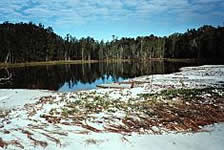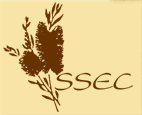 • Creation
• Creation
• Ownership
• Agreements
• Wetlands
• Gateway Proposal
• Horses
• Towra as an Airport
|
Unique Towra Point |
Wetlands
Seagrasses
The waters around Towra Point support meadows of seagrasses. The main species are eelgrass (Zostera), strap weed (Posidonia) and paddle weed (Halophila). Preferring a soft sedimental bed like sand and mud, these flowering plants grow below the low tide level in the sheltered shallow waters.
Mangroves
The majority of mangroves are concentrated on the tidal margins of the bays. They excrete salt from their leaves and have the remarkable ability to change salt water into fresh. Mangroves produce significant amounts of leaf litter called "detritus", which breaks down and provides food for aquatic plants and invertebrate animals. They help to reduce water pollution, provide shelter, refuge and food for many forms of marine life, prevent bank erosion and act as nurseries for fish species.
Saltmarshes
Saltmarshes are distinguished by an absence of trees and are dominated by herbs, grasses and low shrubs. A saltmarsh is only covered by high tide during 'king tides' (the highest of the spring tides) which occur three or four times a year. The vegetation is limited to rushes, succulents, sedges and a few other salt-tolerant plant communities growing in the waterlogged soils. Mangroves and saltmarshes co-exist.
Towra Dunes
These dunes were excavated in the mid 20 th century, leaving man-made lakes as deep as 10 metres below sea level. It has taken more than two decades since the ending of the sandmining on Towra for the artificial lakes to evolve into fragile ecosystems which sustain a population of the endangered Green and Golden Bell Frog and migratory and wading birds.
Littoral Forest
Small groves of littoral rainforest in the Reserve support endangered plant species. In the rainforest areas the canopy is sometimes closed, above an understorey of ferns; but today the native seedlings are struggling to survive against the impact of an invasion by lantana. Introduced noxious weeds and feral animals also pose a threat to all flora and fauna in the Reserve. Fortunately the volunteer 'Friends of Towra' and parties organised by the Sutherland Shire Environment Centre, with assistance of the National Parks and Wildlife Service, have regular working bees targeting these invaders and carrying out native bush regeneration.
Towra Lagoon
Captain Cook mapped Towra Lagoon in 1770 as a fresh water lake. Unfortunately, dredging in the once shallow Botany Bay has increased the intensity of waves hitting Towra Point, threatening its overall ecology and causing the water in the lagoon to become extremely brackish so that its previous inhabitants such as the tortoise have disappeared. Some 40 metres of beach in front of the lagoon has been eroded. During 1997-98 environmentalist Bernie Clarke and the Environment Centre co-ordinated the construction of the 'Great Wall of Towra', a sandbag levee aimed at protecting Towra Lagoon from further inundation of salt water from Botany Bay. Unfortunately a big storm in May 1999 breached the wall. |
  |
 |
| top of page |
|
| |
|



